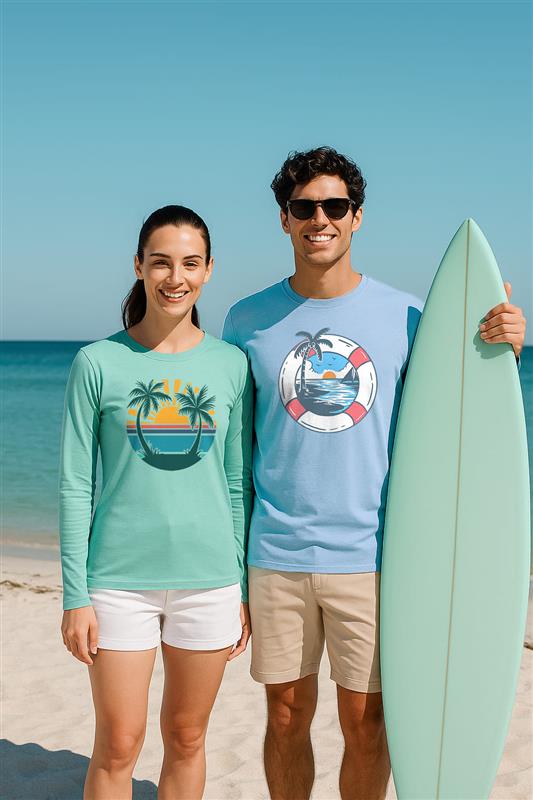Lightweight Long Sleeve Hiking Shirts For Summer Treks

What you actually wear when you're on the trail is more than you might think. A quality lightweight long-sleeve hiking shirt doesn't only cover your skin—it keeps you comfortable. It protects your skin from the sun, wind, and even a small amount of rain.
These tops are constructed with unique fabric that dries quickly and draws sweat away from your body. That leaves you dry, cool, and not clingy even on longer hikes.
If you've been thinking about why these shirts are so effective and how to pick one, you've arrived at the right place. We'll inform you of what to do and also let you know what you should do prior to shopping.
Key Takeaways
-
A long-sleeve light top is ideal for relaxation and protection while hiking.
-
Ventilation fabric keeps you cool, dry, and awake on the trail.
-
Each hike improves when you're wearing the ideal shirt.
Why Is A Lightweight Long Sleeve Shirt Best For Hiking?
A lightweight, long-sleeve hiking top keeps your skin protected from the sun. With additional protection, you can hike hours without sunburn.
Long sleeves prevent bugs, sticks, and thorny shrubs from touching your skin while you're hiking. You stay warm and protected, even in overgrown plant paths.
Quick-drying tees pull sweat away from your body. During hiking, you stay cooler and drier.
Key Benefits
|
Feature |
Benefit |
|
Lightweight Fabric |
Less Bulk And Easy To Move |
|
Long Sleeves |
Better Sun And Bug Protection |
|
Breathable Material |
Keeps You Cool And Dry |
Also, wearing a light shirt can prevent chafing from your backpack straps. It gives an extra layer of softness between your skin and your gear.
They come in a number of colors and styles. They're small enough to pack, so it's handy to have a spare in your pack.
Such a shirt is easy to take care of and also performs well in hot and cold climates. It is always a good idea to reuse an item of clothing.
Do Long-Sleeve Shirts Keep You Cool While Hiking?
A light long-sleeve shirt is cool because it shields your skin from the sun. Instead of having direct sunlight on your arms, the material acts as a shield so that you won't get sunburned.
Some hiking shirts employ special fabric. These pull sweat off of your body. If sweat evaporates faster, your skin will be cooler and less tacky.
Some of the following keeps you cool:
-
Breathable fabrics (allow heat to escape).
-
Moisture-wicking (pulls sweat away from your skin).
-
UPF protection (repels harmful UV rays).
|
Feature |
How It Keeps You Cool |
|
Breathable |
Allows Air to Pass Through |
|
Moisture-Wicking |
Evaporates Sweat, Feels Less Wet |
|
Light Colors |
Reflects Sunlight |
|
Loose Fit |
Allows Air to Flow Around Your Skin |
Loose fit helps too. If your shirt doesn't fit close to your body, more air can circulate around you, allowing sweat to evaporate even faster.
While wearing a long-sleeved shirt will feel warmer to begin with, it is more comfortable on warm days since your skin is covered and protected to a greater extent.
What Smart Hikers Look For In A Hiking Shirt
A lightweight long-sleeve hiking shirt will give you more comfort when hiking. Your skin will be protected and warm, and so your hike will be safer and more enjoyable.
Some of the things you will consider before purchasing a hiking shirt are as follows:
Breathability And Moisture-Wicking
A good trekking shirt has breathable fabric through which air can move. Thin-weave polyester, mesh panels stop sweat from accumulating. Venting is required when ascending a hill or walking during the day.
Moisture-wicking is the techno term for saying that the shirt pulls sweat off your body so it doesn't rub and heat you up. Due to this, shirts usually employ synthetic fibers such as polyester or nylon. Shirts also have antibacterial treatments that restrict odor so you will be odor-free.
Seek out details such as vented underarms or zip-up necks for even more ventilation. A good blend of moisture-wicking and ventilation dries out your skin and keeps it happy—even on multi-hour hikes.
UV Protection
UV protection is also usually included in long-sleeved hiking shirts to protect your skin from the harmful rays of the sun. A UPF of 30 or more is enough on the material. The most lethal UVB and UVA rays are blocked by shirts that have a UPF of 30 or better.
Major benefits of UV protection:
-
Reduces the likelihood of sunburn.
-
Reduces long-term skin damage.
-
Replaces the need for thick sunscreen on covered skin.
Quick-Drying Fabrics
Quick-drying clothing is necessary for hiking in rain or when you are sweating excessively. Cotton takes longer to dry compared to polyester or nylon. If it rains or you need to wade, this prevents you from getting soaked or cold.
Quick-drying shirts allow you to wash them at night and have them ready to wear again in the morning. They also prevent chills if the weather suddenly changes. Some hikers prefer shirts with water-repellent treatments to add an extra level of protection.
Check the label when you choose a hiking shirt to see about drying times or fabric labels like "rapid dry." When you're on multi-day hikes, this can really make a difference to your comfort level.
The Fabric That Can Make Or Break Your Hike
Your hiking shirt's weight, comfort, and coolness or dryness can all be controlled by the fabric you choose. The fabric also determines how simple it is to clean and how quickly your shirt dries.
Synthetic Fabrics
For hiking shirts, synthetic materials like nylon and polyester are common. Sweating won't stick to your skin because they dry extremely fast. When you hike for a few hours at a time, this makes you cooler and drier.
Since nylon and polyester are light in weight, your backpack will become lighter. While traveling, they are a breeze to wash and dry and won't wrinkle. To avoid sunburn, most of these synthetic tops also have UPF (Ultraviolet Protection Factor).
Something to remember: synthetics hold odor longer than some natural fibers. Most companies, though, treat them to assist in resisting odor. Synthetic tees will sometimes not feel as comfortable as cotton, but most are treated to soften the texture.
|
Feature |
Polyester |
Nylon |
|
Quick Drying |
Yes |
Yes |
|
Lightweight |
Yes |
Yes |
|
Odor Control |
Sometimes |
Sometimes |
|
Sun Protection |
Often (UPF) |
Often (UPF) |
Natural Fibers
Some hiking shirts are made of natural fibers such as bamboo or merino wool. Merino wool is breathable and will be comfortable in cold and warm weather. Merino wool also naturally fights odor so you can wear the same shirt longer before it needs to be washed.
Natural fibers are soft and silky to the touch. Merino wool is favored by many for comfort during multi-day backpacking trips. Bamboo is another option; it's soft and absorbent, but takes longer to dry than synthetics.
Natural materials are perhaps pricier and take longer to dry if they get wet. Their smell control and comfort are, however, major benefits for most backpackers.
-
Merino Wool: Moisture-wicking, odor-resistant, temperature-control
-
Bamboo: Soft, absorbent, sustainable
Blended Materials
Synthetic and natural fiber mixtures are used in blended shirts. A shirt could be 60% polyester and 40% merino wool, for example. The mixes try to offer fast drying, softness, and odor resistance. A mix can offer you the best of both worlds.
With repeated washing, the synthetic component dries quickly and holds the shape of the shirt. The natural component offers comfort and helps combat odor.
Shirts made of blended fabric last longer than single natural fiber shirts. Blends can be lighter and more compact to pack than puffy wool shirts. Choosing a blend gives you a good mix of performance, comfort, and durability.
What Makes A Breathable And Quick-Drying Hiking Shirt?
You need to consider the material of a long-sleeved hiking shirt when you choose one. When you're on the trail, proper gear keeps you dry and comfortable.
Polyester and nylon are among the synthetic materials that work well. They dry quickly by drawing perspiration from your body. These garments also allow air to flow more freely.
Polyester is very popular because it dries quickly and is gentle. Most companies blend it with a little bit of spandex to stretch.
Nylon is lightweight and works well against wear. It's also quick-drying in rain or after sweating.
Merino wool is a natural option. It's soft and odor-repelling. Though it won't dry out as fast as polyester or nylon, it's still a decent breathability option.
Look for shirts that are labeled as moisture-wicking or quick-dry. These features make hiking in the heat or humidity a lot more enjoyable. A good shirt keeps you cool, dry, and focused on your hike.
|
Material |
Breathability |
Quick-Drying |
Comfort |
|
Polyester |
High |
High |
Soft |
|
Nylon |
High |
High |
Lightweight |
|
Merino Wool |
Medium |
Medium |
Soft, Natural |
The One Long Sleeve Shirt You'll Be Waiting for This Summer
Lightweight, long-sleeved hiking shirt for warm-weather adventures. Stays dry, cool, and protected from the sun on every hike thanks to breathable, quick-drying fabric and UPF 50+ sun protection. Lightweight, silky fabric and ventilated panels for long-lasting comfort by avoiding chafing. Perfect for sunwear casuals, hiking, and fishing.
Top Features
|
Feature |
Why It Matters |
|
Lightweight Fabric |
Trims bulk, maximizes mobility |
|
Breathable Material |
Stays dry and cool |
|
Moisture-Wicking |
Pulls sweat off skin in an instant |
|
UPF Sun Protection |
Shields skin from harmful UV rays |
|
Quick-Drying Fabric |
Dries in an instant, minimizes discomfort |
Tips To Wash And Store Your Long Sleeve Hiking Shirt
-
Wash your light hiking shirt in cold water using a mild detergent.
-
Do not use bleach or fabric softener, which can compromise the fibers of the shirt and its performance.
-
Dry your shirt by air instead of a dryer if possible. Heat can ruin the fabric and shrink it. Hang or lay flat to preserve the shape.
-
If your shirt gets dirty, wash them immediately. Rub a small quantity of soap on the stain lightly and wash out in cold water before washing.
-
Keep your clean shirt in a cool dry place. Don't keep it wet, as this may produce mildew or odors.
-
Inspect for loose threads or tears prior to and following every excursion. Quick fixes with needle and thread will prolong the life of your shirt.
|
Step |
What To Do |
Why |
|
Washing |
Use Cold Water, Mild Detergent |
Protects Fibers |
|
Drying |
Air Dry, Avoid High Heat In Dryer |
Prevents Damage |
|
Stain Removal |
Spot Treat With Soap And Cold Water |
Removes Stains |
|
Storage |
Store Dry, In A Cool Place |
Prevents Mold |
Frequently Asked Questions
What Are The Best Long Sleeve Hiking Shirts For Sun Protection?
Two of the best ones are polyester and nylon. Both have inherent UPF ratings that prevent your skin from absorbing the sun's rays. Merino wool also has natural protection from the sun and is extremely comfortable against the skin.
Which Lightweight Long-Sleeve Shirts Are Best For Trekking In Hot Climates?
Hot weather demands merino wool, nylon, or lightweight polyester shirts. Select shirts with venting and mesh panels to allow air flow. Moisture-wicking treatments dry you out and prevent sweat from becoming uncomfortable.
How Do Long-Sleeve Shirts With Quick-Dry Materials Help Hikers?
Quick-drying shirts remove the sweat from your skin and dry rapidly. They make you feel comfortable while on long walks and prevent rubbing. In addition, fast-drying fabric makes wet weight clothing lighter.
What Are Some Men's Long-Sleeve Hiking Shirts That Combine Durability And Light Weight?
Strong and lightweight, ripstop nylon or reinforced polyester versions also exist. Some brands have a tendency to use these fabrics for added durability in rough conditions. Double stitching on seams also helps shirts be longer-lasting yet still lightweight.



